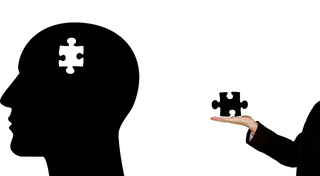Depression
"The Midnight Library" and the Therapeutic Alliance
"The Midnight Library" shows how the therapeutic alliance enables healing.
Posted November 1, 2022 Reviewed by Michelle Quirk
Key points
- Matt Haig's wonderful novel offers an allegory of a course of therapy in which the therapeutic alliance is crucial to healing from depression.
- A good relationship with a therapist helps a person to make other connections both within their own mind/brains and with others.
- "The Midnight Library" imaginatively depicts core processes at the heart of the therapeutic alliance.
Matt Haig’s The Midnight Library gets depression spot on. A defining feature of the condition is its capacity to skew perception, to put a distorting lens over one’s vision of the world so that everything looks negative and hopeless. The main character, Nora Seed, who attempts suicide at the start of the novel, views her life through this lens, looking back on a journey in which every step taken was wrong, in which she was incompetent and insufficient, and in which she had created a life for herself that was not worth living. Hovering between life and death after consuming an overdose of pills, Nora wakes up in the Midnight Library, a place in which she chooses volumes that enable her to lead alternative lives (the idea of quantum multiverses informs this novel).

The rules of borrowing: If it becomes clear to Nora that a given life/volume is not what she wants, she will return to the library. One brilliant touch: The first volume she encounters is not a life/volume but The Book of Regrets, a tome so heavy she can barely lift it. It gets lighter with each return to the library.
The very first “book” Nora borrows shows her that depression has skewed her perceptions. Among “the regrets that were on permanent repeat in her mind,” she decided not to marry her fiancé Dan. She gets to redo that decision when she begins to read and finds herself outside the country pub that they own together (that had been his dream). Meeting her husband in this life shows that she has had little to regret in her “root” existence, the one in which she wanted to die. Dan drinks too much and has been unfaithful.
But it isn’t learning about Dan’s future behavior that is important for Nora. Rather, it is reconnecting with her past observations, perceptions that had been filtered out by the depressive lens. When he laughs at her for knowing the name of a mountain range in Africa, “because while most people were into rock music you were into actual rocks,” she remembers “how often during their relationship Dan’s humour hinged on other people, specifically Nora.” She recalls that he had been unappreciative and underwhelmed by the song she had written, her best song ever, to celebrate their new life together. And he had undermined her dreams and ambitions, threatening to break up with her if she began a career as a singer. Nora ditched her fiancé for good reasons, and when she finds herself hating the life she had regretted abandoning, she finds herself back in the library.

The solution to Nora’s depression isn’t just magic, or, to put this another way, her healing comes from a magic available in our ordinary world, where we are all confined to our “root” lives. This is the healing that comes from a therapeutic alliance, a relationship that allows her to think through feelings and experiences in a safe space in the presence and with the support of an empathetic and astute guide. Nora finds this relationship with the librarian, Mrs. Elm, who had been the librarian in Nora’s high school.
Nora had felt at home in the library, and she went there whenever she could because Mrs. Elm was a stable and comforting presence, which she needed given her troubled family life. When Nora’s father died suddenly of a heart attack, Mrs. Elm had been the one to break the news: “Mrs. Elm had held her, stroking and smoothing the back of her head like a baby, not offering platitudes or false comforts or anything other than concern.” Mrs. Elm knew exactly what Nora needed to begin to cope with her grief.
The Mrs. Elm in the Midnight Library both is and isn’t the Mrs. Elm from Nora’s life. She embodies the qualities that were so therapeutic for young Nora, but she is much more of a guide in this library of alternative lives. Nora’s exploration of other lives allegorizes the work of therapy, giving Nora a chance to explore why she made the decisions that she regrets so intensely and to see that she might not have been so wrong after all.
Depression induces disconnection—from others (even those who are loved), from aspects of oneself, from a wide range of emotions and experiences. It traps a person in a ruminative loop of despairing thoughts and feelings. A therapeutic alliance, which has been shown to be a significant factor in healing across different treatment approaches, offers a connection that fosters the capacity to form other connections, to revitalize that which has been lost. Mrs. Elm’s care and guidance enable Nora to begin that process.
Nora is fully alive to both herself and to others when she finally discovers the life that is right for her. And in that life she finds both the wisdom and practice of connecting with others, seeking out the people who matter (and to whom she matters), extending friendship, and healing painful rifts. When Nora reflects on her “reading,” she writes, “So let’s be kind to the people in our existence. Let’s occasionally look up from the spot in which we are because, wherever we happen to be standing, the sky goes on forever.” She has broken through the prison-house of depression, the enclosure within one’s own egoism and misery, to view herself as part of a larger world in which her relationships with others matter. The therapeutic alliance with Mrs. Elm has enabled this capacity for connection.

When Nora’s father died, Mrs. Elm spoke words that she has occasion to speak again in the library: “Things will get better Nora. It’s going to be all right.” She voices the implicit promise of therapeutic practice, extended from the start, and conveyed by the understanding and acceptance at the core of the therapeutic alliance.
If you or someone you love is contemplating suicide, seek help immediately. For help 24/7 dial 988 for the 988 Suicide & Crisis Lifeline, or reach out to the Crisis Text Line by texting TALK to 741741. To find a therapist near you, visit the Psychology Today Therapy Directory.
References
Wampold, Bruce E. and Zac E. Imel (2015). The Great Psychotherapy Debate: The Evidence for What Makes Psychotherapy Work. New York: Routledge.




